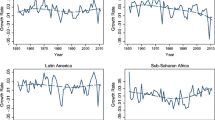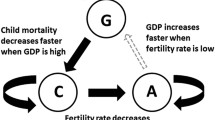Abstract
This paper develops the theoretical foundations and the testable implications of the various mechanisms that have been proposed as possible triggers for the demographic transition. Moreover, it examines the empirical validity of each of the theories and their significance for the understanding of the transition from stagnation to growth. The analysis suggests that the rise in the demand for human capital in the process of development was the main trigger for the decline in fertility and the transition to modern growth







Similar content being viewed by others
Notes
The Princeton Project on the Decline of Fertility in Europe, carried out in the 1960s and 1970s, attempted to characterize the decline of fertility in Europe during the nineteenth and early twentieth centuries. The project suggests that social and economic forces played little role in the onset of fertility transition. The methodology used in this research has been discredited over the years (e.g., Guinnane et al. 1994; Brown and Guinnane 2007), and economic forces are currently viewed as central to this transition.
One can attribute most changes in economic regimes to changes in the nature of preferences. However, since preferences, as opposed to choices, are largely unobservable, theories that rely on changes in preferences are not refutable.
Alternatively, τy can be viewed as a monetary cost associated with raising each child by paying for a fraction τ of a caretaker’s time. The addition of nontime costs would not affect the qualitative insights.
The price of consumption is normalized to 1.
For simplicity, it is assumed that parents derive utility from the expected number of surviving offspring and that the parental cost of child rearing is associated only with surviving children. The introduction of costs associated with nonsurviving children, or risk aversion, would not affect the qualitative features of the theory.
GDP per capita was measured in 1990 international dollars.
One could sensibly argue that the income thresholds at which the substitution effect dominates differ across this set of countries due to sociocultural and distributional factors. However, the likelihood that these differential thresholds would be reached in the same decade across a large number of countries appears remote.
If the number of children is modeled as an integer rather than a continuous variable, then the maximization problem would have to be modified to account for uncertainty (e.g., Kalemli-Ozcan 2002). Nevertheless, the qualitative prediction as outlined in this section would not be altered.
In contrast, evolutionary forces would lead to the selection of preferences with higher risk aversion with respect to consumption Galor and Michalopoulos 2006.
Furthermore, if the physiological constraint on the feasible number of births per woman is binding for some households under a high-mortality regime, a reduction in mortality would operate to increase the number of surviving offspring.
One could argue that the decline in mortality was not internalized into the decisions of households who had difficulties separating a temporary decline from a permanent one. However, this argument is highly implausible, given that mortality declined monotonically for nearly 140 years prior to the demographic transition. It is inconceivable that six generations of households did not update information about mortality rates in their immediate surroundings, keeping the collective memories about mortality rates prevalent more than a century earlier.
In contrast, Eckstein et al. (1999)’s structural quantitative analysis of the demographic transition in Sweden suggests that mortality decline played a role in the demographic transition. Their underlying theoretical structure requires conditions (3) and (4) as well as specific interactions among mortality, wages, and the return to human capital.
The evolution of fertility and mortality in less developed economies has been partly affected by policies advanced by developed economies. A comprehensive overview of these patterns is provided by Schultz (1997).
The effect of the rise in demand for human capital on parental choice of quality and quantity of offspring is discussed by Becker (1981). Becker et al. (1990) explore the role of luck in determination of the relative timing of the demographic transition and thus the wealth of nations. As they argue on page S13, “Many attempts to explain why some countries have had the best economic performance in the past several centuries give too little attention to accidents and good fortune.” In their theory, a major shock shifts the economy from the basin of attraction of a high-fertility to a low-fertility steady-state equilibrium, generating, counterfactually, a monotonic decline in fertility rates along with a monotonic rise in income per capita. However, existing evidence shows that the process of industrialization and the associated increase in income per capita were accompanied by a sharp increase in population growth, prior to its decline during the course of the demographic transition. Moreover, although they define the low output, high population growth steady state as a Malthusian steady-state equilibrium, it has none of the features of a Malthusian equilibrium; population growth rate is not at the replacement level, it is, counterfactually, higher than that in the beginning of the demographic transition. Furthermore, a small positive shock to income when the economy is in the “Malthusian” steady state initially decreases fertility, in contrast to the central aspect of Malthusian equilibrium.
Once again, it is assumed that parents derive utility from the expected number of surviving offspring and the parental cost of child rearing is associated only with surviving children. The introduction of costs associated with nonsurviving children, or risk aversion, would not affect the qualitative features of the theory.
If the elasticity of child quality with respect to the cost of child quality is smaller than one (in absolute value), an increase in the cost of education increases the overall investment in child quality and thus the number of children declines. However, if the elasticity is greater than one, the number of children increases.
In contrast to Becker and Lewis (1973), a rise in parental income (possibly due to a rise in the return to their education) does not necessarily generate a substitution from child quantity to child quality. Instead, an increase in the household’s earning capacity, y, due to the rise in the wage per efficiency unit of labor, generates two conflicting effects. On the one hand, the rise in y also generates a positive income effect that operates to increase the number of children. On the other hand, the rise in y generates a negative substitution effect that reflects an increase in the opportunity cost of raising a child, \(y[\tau ^{q}+\tau ^{e}e]\). If preferences are homothetic, the income effect and the substitution effect cancel each other. Then, the optimal number of children and their quality are independent of the parental level of income.
They find that a lower cost of education, as proxied by lower land concentration, had an adverse effect on fertility and education in the middle of the nineteenth century and on the extensiveness of the fertility decline toward the end of the nineteenth century.
Quantitative evidence provided by Greenwood and Seshadri (2002) is supportive of the role played by the rise in the demand for skilled labor in the demographic transition in the United States. They demonstrate that the faster pace of technological progress in an industrial skilled-intensive sector as opposed to an unskilled-intensive agricultural sector generates a demographic pattern that matches the data on the US demographic transition.
Significant child allowances in these countries may mitigate the adverse effect on child quality and may therefore obscure the adverse effect of quantity on quality.
See Galor and Moav (2004) for the optimal allocation of intergenerational transfers between investment in human capital and the transfer of physical capital.
Hazan (2009) has argued that the lengthening of life expectancy toward the end of the nineteenth century had no effect on the length of working life and thus could not be viewed as an incentive for investment in human capital. However, as established by Sheshinski (2009), when survival probabilities rise at all ages, behavioral response depends on changes in the hazard rate. An increase in life expectancy may lead to higher investment in education. Moreover, the increase in the health of children enhanced their productivity in human capital formation and thus increased the relative return to investment in child quality (Hazan and Zoabi 2006).
Young (2005) argues that a widespread community infection (i.e., the AIDS epidemic in Africa) lowers fertility, both directly, through a reduction in the willingness to engage in unprotected sexual activity, and indirectly, by increasing the scarcity of labor and the value of a woman’s time.
Hazan (2009) has argued that the lengthening of life expectancy towards the end of the nineteenth century had no effect on the length of the working life and thus could not be viewed as an incentive for investment in human capital. However, the associated increase in students health enhanced their productivity in human capital formation and thus increased the relative return to child quality (Hazan and Zoabi 2006).
As long as the bias toward child quality is moderate, the additional income generated dominates that bias toward quality and allows for a higher reproduction success rate.
In the contemporary era, Heckman and Walker (1990) find a negative effect of women’s wages and a positive effect of men’s income on birth rates.
It should be noted, however, that if the wealth of the rich is based on nonwage income, it would be associated with a pure income effect, which could result in higher fertility rates, despite a reduced need for old-age support.
Clearly, the increased demand for human capital has not necessarily resulted in an increase in the rate of return to human capital due to institutional changes (e.g., the provision of public education) that lowered the cost of investment in human capital and facilitated a massive increase in the supply of education (Galor 2005, Sect. 2.3.3.).
The data on the time elapsed since the demographic transition is derived from Reher (2004).
It should be noted, however, that if the wealth of the rich is based on nonwage income, it would be associated with a pure income effect, which could result in higher fertility rates, despite a reduced need for old-age support.
References
Angrist JD, Lavy V, Schlosser A (2010) Multiple experiments for the causal link between the quantity and quality of children. J Labor Econ 28(4):773–824
Becker GS (1960) An economic analysis of fertility. In: Becker GS (eds) Demographic and economic change in developed countries. Princeton University Press, Princeton, pp 209–231
Becker GS (1981) A treatise on the family. Harvard University Press, Cambridge
Becker GS, Lewis HG (1973) On the interaction between the quantity and quality of children. J Polit Econ 81(2, Part II):S279–S288
Becker GS, Murphy KM, Tamura R (1990) Human capital, fertility, and economic growth. J Polit Econ 98(5):S12–S37
Becker SO, Cinnirella F, Woessmann L (2009) The trade-off between fertility and education: evidence from before the demographic transition. CESifo Working Paper No. 2775
Becker SO, Woessmann L (2009) Was weber wrong? A human capital theory of protestant economic history. Q J Econ 124(2):531–596
Black SE, Devereux PJ, Salvanes KG (2005) The more the merrier? The effect of family size and birth order on children’s education. Q J Econ 120(2):669–700
Bleakley H, Lange F (2009) Chronic disease burden and the interaction of education, fertility, and growth. Rev Econ Stat 91(1):52–65
Boldrin M, Jones LE (2002) Mortality, fertility, and saving in a Malthusian economy. Rev Econ Dyn 5(4):775–814
Botticini M, Eckstein Z (2005) Jewish occupational selection: education, restrictions, or minorities? J Econ Hist 65(4):922–948
Brown JC, Guinnane TW (2007) Regions and time in the European fertility transition: problems in the Princeton project’s statistical methodology. Econ Hist Rev 60(3):574–595
Caldwell JC (1976) Toward a restatement of demographic transition theory. Popul Dev Rev 2(3-4):321–366
Chesnais J (1992) The demographic transition: stages, patterns, and economic implications. Clarendon Press, Oxford
Cipolla CM (1969) Literacy and development in the west. Harmondsworth, Middlesex
Doepke M (2004) Accounting for fertility decline during the transition to growth. J Econ Growth 9(3):347–383
Doepke M (2005) Child mortality and fertility decline: does the Barro-Becker model fit the facts? J Popul Econ 18(2):337–366
Eckstein Z, Mira P, Wolpin K (1999) A quantitative analysis of Swedish fertility dynamics: 1751–1990. Rev Econ Dyn 2(1):137–165
Fernández-Villaverde J (2001) Was Malthus right? Economic growth and population dynamics. Working paper, Department of Economics, University of Pennsylvania
Flora P, Kraus F, Pfenning W (1983) State economy and society in Western Europe 1815–1975, vol 1. Palgrave Macmillan, London
Frankel JA, Romer D (1999) Does trade cause growth? Am Econ Rev 89(3):379–399
Galor O (2005) From stagnation to growth: unified growth theory, handbook of economic growth, vol IA. Elsevier North-Holland, Amsterdam
Galor O (2010) The 2008 Lawrence R. Klein lecture-comparative economic development: insights from unified growth theory. Int Econ Rev 51(1):1–44
Galor O, Michalopoulos S (2006) The evolution of entrepreneurial spirit and the process of development. Working paper, Department of Economics, Brown University
Galor O, Moav O (2002) Natural selection and the origin of rconomic growth. Q J Econ 117(4):1133–1191
Galor O, Moav O (2004) From physical to human capital accumulation: inequality and the process of development. Rev Econ Stud 71(4):1001–1026
Galor O, Mountford A (2006) Trade and the great divergence: the family connection. Am Econ Rev 96(2):299–303
Galor O, Mountford A (2008) Trading population for productivity: theory and evidence. Rev Econ Stud 75(4):1143–1179
Galor O, Weil DN (1996) The gender gap, fertility, and growth. Am Econ Rev 86(3):374–387
Galor O, Weil DN (1999) From Malthusian stagnation to modern growth. Am Econ Rev 89(2):150–154
Galor O, Weil DN (2000) Population, technology, and growth: from Malthusian stagnation to the demographic transition and beyond. Am Econ Rev 90(4):806–828
Goldin C (1990) Understanding the gender gap: an economic history of American women. Oxford University Press, New York
Greenwood J, Seshadri A (2002) The US demographic transition. Am Econ Rev 92(2):153–159
Greenwood J, Seshadri A, Vandenbroucke G (2005) The baby boom and baby bust. Am Econ Rev 95(1):183–207
Guinnane TW, Okun BS, Trussell J (1994) What do we know about the timing of fertility transitions in Europe? Demography 31(1):1–20
Hanushek EA (1992) The trade-off between child quantity and quality. J Polit Econ 100(1):84–117
Hazan M (2009) Longevity and lifetime labor supply: evidence and implications. Econometrica 77(6):1829–1863
Hazan M, Zoabi H (2006) Does longevity cause growth? A theoretical critique. J Econ Growth 11(4):363–376
Heckman JJ, Walker JR (1990) The relationship between wages and income and the timing and spacing of births: evidence from Swedish longitudinal data. Econometrica 58(6):1411–1441
Hernandez DJ (2000) Trends in the well being of America’s children and youth. U.S. Department of Health and Human Services, Washington
Herzer D, Strulik H, Vollmer S (2010) The long-run determinants of fertility: one century of demographic change 1900–1999. Working paper, University of Hannover, Hannover
Hindle S (2004) On the Parish: the micro-politics of poor relief in rural England c. 1550–1750. Clarendon Press, Oxford
Jones LE, Tertilt M (2006) An economic history of fertility in the US: 1826–1960. NBER working paper No. 12796
Kalemli-Ozcan S (2002) Does the mortality decline promote economic growth?. J Econ Growth 7(4):411–439
Klemp MPB, Weisdorf JL (2010) The child quantity-quality trade-off: evidence from the population history of England. Mimeo, Department of Economics, University of Copenhagen
Lagerlöf N-P (2003) Gender equality and long-run growth. J Econ Growth 8(4):403–426
Lehr CS (2009) Evidence on the demographic transition. Rev Econ Stat 91(4):871–887
Li H, Zhang J, Zhu Y (2008) The quantity-quality trade-off of children in a developing country: identification using Chinese twins. Demography 45(1):223–243
Maddison A (2001) The world economy: a millennial perspective. OECD, Paris
Maddison A (2008) The west and the rest in the world economy: 1000–2030. World Econ 9(4):75–99
Murphy TE (2009) Old habits die hard (sometimes): what can Département heterogeneity tell us about the French fertility decline? Technical report, MIMEO
Murtin F (2009) On the demographic transition. OECD
Neher PA (1971) Peasants, procreation, and pensions. Am Econ Rev 61(3):380–389
Pelling M, Smith RM (1991) Life, death and the elderly: historical perspectives. Routledge, London
Reher DS (2004) The demographic transition revisited as a global process. Popul Space Place 10:19–42
Rosenzweig MR, Wolpin KI (1980) Testing the quantity-quality fertility model: the use of twins as a natural experiment. Econometrica 48(1):227–240
Rosenzweig MR, Zhang J (2009) Do population control policies induce more human capital investment? Twins, birth weight and china’s “one-child” policy. Rev Econ Stud 76(3):1149–1174
Schultz TP (1985) Changing world prices, women’s wages, and the fertility transition: Sweden, 1860-1910. J Polit Econ 93(6):1126–1154
Schultz TP (1997) Demand for children in low income countries. Handb Popul Fam Econ 1:349–430
Sheshinski E (2009) Uncertain longevity and investment in education
U.S. Bureau of the Census (1975) Historical statistics of the United States: colonial times to 1970, part 1, Series D 830–844, p172
Wrigley EA, Schofield R (1981) The population history of England, 1541–1871: a reconstruction. Cambridge University Press, Cambridge
Young A (2005) The gift of the dying: the tragedy of AIDS and the welfare of future African generations*. Q J Econ 120(2):423–466
Author information
Authors and Affiliations
Corresponding author
Rights and permissions
About this article
Cite this article
Galor, O. The demographic transition: causes and consequences. Cliometrica 6, 1–28 (2012). https://doi.org/10.1007/s11698-011-0062-7
Received:
Accepted:
Published:
Issue Date:
DOI: https://doi.org/10.1007/s11698-011-0062-7




